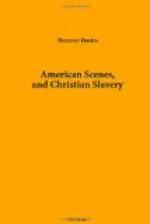he beat her, uttering fearful curses. If he caught
her praying, he said, he would “give her
hell.”
Mary was a member of the Methodist Church in Washington.
There were several pious people in the company; and
at night, when the driver found them melancholy and
disposed to pray, he had a fiddle brought, and made
them dance in their chains, whipping them till they
complied. Mary at length became so weak that
she really could travel on foot no further. Her
feeble frame was exhausted, and sank beneath accumulated
sufferings. She was seized with a burning fever;
and the diabolical trader—not moved with
pity, but only fearing he should lose her—placed
her for the remainder of the way in a waggon.
Arriving at Natchez, they were all offered for sale.
Mary, being still sick, begged she might be sold to
a kind master. Sometimes she made this request
in the hearing of purchasers, but was always insulted
for it, and afterwards punished by her cruel master
for her presumption. On one occasion he tied
her up by the hands so that she could barely touch
the floor with her toes. He kept her thus suspended
a whole day, whipping her at intervals. In any
other country this inhuman beast would have been tried
for the greatest crime, short of murder, that man
can commit against woman, and transported for life.
Poor Mary Brown was at length sold, at 450 dollars,
as a house-servant to a wealthy man of Vicksburgh,
who compelled her to cohabit with him, and had children
by her,—most probably filling up the measure
of his iniquity by selling his own flesh. Wrongs
like these must have inspired our poet when he exclaimed,—
“To think that man—them just and
gentle God—Should stand before Thee with
a tyrant’s rod O’er creatures like himself,
with souls from Thee, Yet dare to boast of perfect
liberty! Away! away! I ’d rather hold
my neck In doubtful tenure from a sultan’s beck,
In climes where Liberty has scarce been named, Nor
any right but that of ruling claimed, Than thus to
live where bastard Freedom waves Her fustian flag
in mockery over slaves!”
As we advanced, we continually met with flat boats,
laden with produce, and floating sluggishly down.
In the vernacular phrase, these boats are called “Kentucky
flats,” or “broad-horns.” They
are curiously constructed. At a distance, they
appear like large chests or trunks afloat. They
are from 50 to 100 feet long, and generally about 15
or 20 feet wide. The timbers of the bottom are
massive beams. The sides are boarded up square
to the height of 6 feet above the water; the roof
being slightly curved, like a trunk lid, to throw off
rain. They are adapted to carry from 200 to 400
barrels. Great numbers of cattle, hogs, and horses
are conveyed to market in them. Coals, too, are
thus brought down from the upper parts of the valley.
Some of these barges have apartments fitted up for
the accommodation of a family, with a stove, beds,
tables, &c. You may sometimes see in them ladies,




